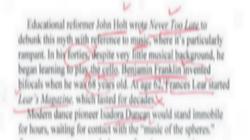| |
Free to Fee: Compile Newsletter or Blog Articles into a Collection People Will Pay For
by Marcia Yudkin
Got content? If you regularly provide tips, advice, case studies or the like in a free newsletter or ezine or on your blog, you may be able to repackage these articles into a free-standing product that readers would happily pay for.
Whether your audience is parakeet owners, paralegals or paranoid landlords, if your information can hang together usefully for that group, and they are willing to spend money on learning what to do better, you can compile previously published material that was and maybe still is free into a paid book, report, ebook or course. Here’s how.
Step 1. Get clear on the audience for your product. (Sometimes you’ve already done this in focusing your newsletter or blog.) Identify a specific kind of person and something they want to accomplish, such as landlords who want to avoid troublesome tenants.
|
Master Information Marketing - From Product Creation to Sales
In seven step-by-step lessons, learn the easiest, most profitable ways to begin packaging and selling what you know. Move from making money only when you're working to enjoying while-you-sleep income.
Launch Your Information Empire course details. |
Step 2. Select articles that fit the focus arrived at in Step 1. Put aside anything that isn’t directly relevant – perhaps you can use those for a different compilation next year.
Step 3. Create a structure for the articles that makes sense for the reader and fits the contents you have on hand. This order might be chronological, according to a series of steps. Or you might be able to group your content under a number of topical headings. Above all, avoid a helter-skelter miscellany. What works best is a structure that looks like it could have been planned that way from scratch.
Step 4. After determining the organization and order of the articles, go through a printout of the entire text and edit with a critical eye – or have someone with good editing skills do that for you. Certain things that seemed fine in the newsletter or on the web may become annoying or nonsensical here.
For instance, one collection I was asked to comment on had many overly long paragraphs and weak closings on the articles. The author also had several passages where it looked like she wasn’t following her own advice elsewhere in the collection. Another collection contained predictions and observations that now seemed old and off the mark. Leave time in your production schedule to improve the text. Again, you want readers to feel you’ve taken care with your product instead of just tossing previously published things together.
|
Begin Sharing What
You Know With Profitable Teleseminars
Discover how to quickly set up, run and
profit from a single teleclass or a
series of teleseminars. Learn why
this technically rather easy and costs
little or nothing to implement.
Find out why teleseminars may make more
sense for you than webinars, and get the
scoop on transforming a one-time event
into an audio product that earns you
money month after month. More
info on presenting teleseminars. |
Step 5. Add exclusives. Provide a foreword that’s new, a newly compiled resource list, to-do suggestions or a few never-published articles – things that go above and beyond what people following you have already seen or received.
Step 6. Reread every page of your text one more time, looking for and fixing anything that might have made sense in your ezine or on your blog but doesn’t fit the new context. This includes time-based references like “this week” and references to current events that will seem dated in a year or two, as well as spatial references like “the box on the right” that no longer apply. If you plan to sell a printed version of the collection, include URLs that are fully written out rather than links consisting of just underlined anchor text.
If nearly all the content from your to-be-published collection is archived on your web site, consider removing some of it, so regular visitors to the site are less likely to feel you’re asking them to pay for something anyone can access for free. Even so, if you follow the steps above, the product will have coherence that influences those who buy to feel they’ve purchased an item of quality. And instead of returns and refund requests, you receive
thank-you’s, testimonials and readers recommending your product to colleagues and friends.
Copyright 2009 Marcia Yudkin. All rights reserved.
|





